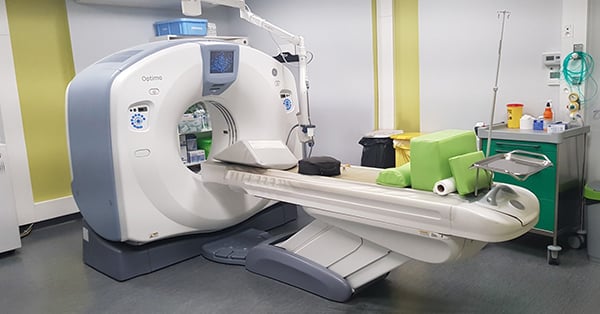
Inside every CT scanner gantry are dozens of specialized electronic components working very hard to emit and detect X-rays. All that hard work builds up an immense amount of heat; enough heat to be hazardous to the functions of the CT if it is not somehow dissipated. To keep CT scanners cool, there are two heat dissipation methods currently available on the market: systems cooled by air and systems cooled by water. The following comparison addresses the advantages of using each cooling type in your CT scan room.
CT Cooling Methods Compared
Remember the last time you used your laptop too long and it made your legs all sweaty? This is a bit like the cooling ideas used in CTs. On one hand, the electronics of the computer were creating heat and the fans inside were dissipating that heat into your legs. On the other hand, your body was also dissipating heat into its own water and sweating it out into your pant legs, leaving you feeling kinda gross and kinda thirsty, but otherwise intact. Though they use completely different mediums, both systems are effective for cooling a sensitive internal environment.
Okay, so the analogy has its limitations. But, there really are both air and water-based cooling methods for CT equipment, and they each have their pros and cons.
Advantage: Water-Cooled
- Rooms with inconsistent humidity and temperature control will affect a water-cooled unit far less than an air-cooled one. Air-cooled units indirectly hand the burden of cooling to the facility in which they are installed in the form of air conditioning maintenance and energy costs. Typically, the heavy lifting for CT temperature regulation falls to the site’s HVAC contractor.
- With the far lower level of fan noise, a properly functioning water-cooled CT scan room can be quieter and warmer than a comparable air-cooled room.
- The inside of a water-cooled gantry is generally cleaner than an air-cooled unit. The many fans on the air-cooled system tend to pull dust, hair, etc. into the gantry.
- Water-cooled systems often have a lower purchase price.
The Best CT Scan Room Temperature and Humidity for Maximum Uptime
Advantage: Air-Cooled
- Air-cooled units have no concerns over water quality. Unless the water quality is monitored at the time a water-cooled unit is filled, water impurities can reduce the performance of the cooling system. Higher temperatures in the gantry can reduce the overall lifespan of components over time.
- Maintenance has to be done to keep water cooling systems in good shape. If the cooling efficiency deteriorates, the system has to work harder to achieve the same effect. Some of the byproducts of this harder work are increased valve wear (and then failure), reduced component life due to higher and varying temperatures, and image inconsistency throughout a patient schedule. It should be noted that a substantial portion of downtime for water-cooled CTs is cooling system related.
- Air-cooled scanners generally have a smaller overall footprint than their water-cooled counterparts.
The Takeaway
Ultimately, the decision to choose one of these systems over the other won’t be made on the contents of a single blog, but it’s our hope that these points have allowed you to walk away with a little more awareness. There are excellent CT scanners that use either of these cooling methods. The question is ultimately one of installation and maintenance.
As you approach this aspect of a CT purchasing decision or any of the many others that will arise, don’t hesitate to contact us if you still have questions. We can help narrow down your search for the right CT scanner for your facility.

Jeremy Block
Jeremy Block is the Senior Vice President of Product Solutions at Block Imaging. Jeremy’s goal is to make your buying or selling experience as easy as possible. Outside of work, Jeremy enjoys Michigan State football, and spending time with his wife and kids.





